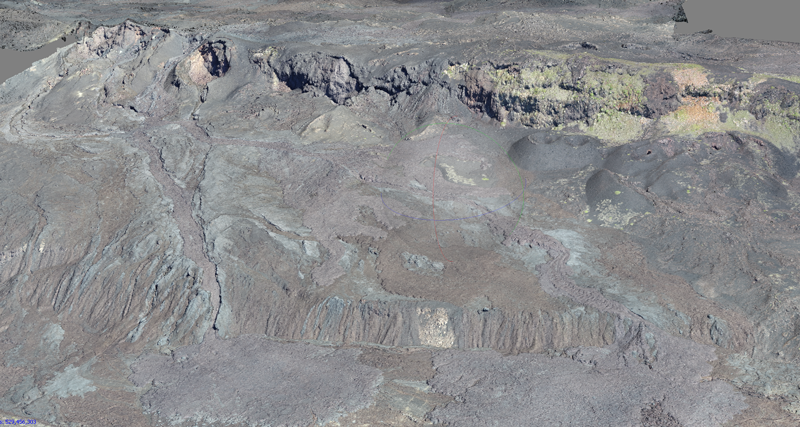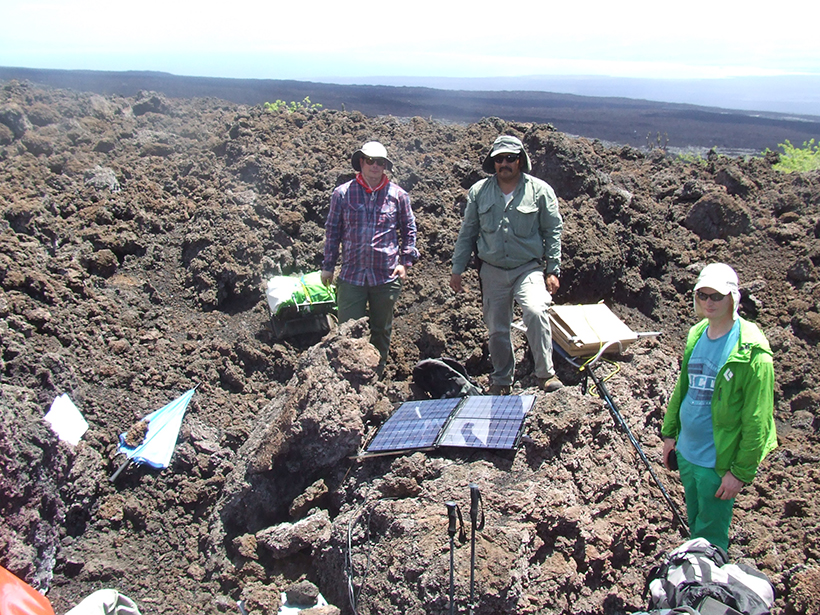It’s a rarity to observe a volcano move through its entire eruption cycle. But a group of scientists did just that by collecting data on Sierra Negra, a volcano that sits on the southeastern part of Isabela, the largest of the islands that comprise the Galápagos Archipelago. The international team captured inflation measurements, seismic rumblings, and lava characteristics before, during, and after the 2018 eruption.
In particular, the researchers note that the basaltic caldera actually went through resurgence, or growth, after eruption—a rarity for this type of volcano. The scientists suggest that their observations at Sierra Negra can provide valuable insights into basaltic eruptions and the importance of international, interdisciplinary collaborations to fully monitor volcanic eruptions.
What Sets the Galápagos Islands’ Basaltic Volcanoes Apart?
Volcanic eruptions can occur in a myriad of landscapes, including on the tropical islands of Hawaii and under Iceland’s glaciers. Recent eruptions at Hawaii’s Kīlauea in 2018 and Iceland’s Bárðarbunga in 2014 spewed lava into their respective regions, and then both calderas had significant subsidence after the eruption.
But the basaltic volcanoes that make up the Galápagos Islands are a bit different. “They have a much higher slope angle than regular shield volcanoes—all of the magma stays inside the caldera,” said Peter La Femina, an integrative volcanologist and coauthor of a new paper in Nature Communications.
Instead of a broad shield, the magma in the Galápagos Islands tends to move upward to create a steeper dome, La Femina said. He added that this change in magma movement is due to the location of the Galápagos. Basaltic shields like Kīlauea or Bárðarbunga are situated on rift systems that can channel the magma away from the caldera.
The geology of the Galápagos Islands is unique, La Femina said. “I think they’re special because…they are dramatically different than Hawaii or Iceland—all of those volcanoes have well-developed rift systems.” But the Galápagos is different—there is no rift zone for the magma to migrate to, he said, adding that “we think, the fundamental stress fields around the volcanoes are different.”
The Details Are in the Monitoring
Although the Galápagos Islands are remote, there is an extensive network of geophysical monitoring systems run by an international consortium of researchers. In total, there are six permanent seismic stations, 10 permanent continuous GPS networks, and remote InSAR (interferometric synthetic aperture radar) surveys of the area.
“It’s just awesome. It’s probably one of the largest, if not the largest, preobstructive inflation events that has been measured.”
Since Sierra Negra erupted in 2005, researchers have been measuring the seismicity and deformation of the volcano. “Between 2005 and 2018, the caldera floor grew about six and a half meters vertically,” said La Femina, adding that “it’s just awesome. It’s probably one of the largest, if not the largest, preobstructive inflation events that has been measured.”
While inflation was occurring, the inner faults in the caldera were under increasing stress, especially the trap door fault—a hinged, U-shaped fault that is an escape hatch for magma.
Changes started to accelerate in late 2017. “The geodetic rate was just going really high, over a meter per year [of uplift], and the seismic rate started going up,” said La Femina.
On 26 June 2018, a magnitude 5.4 earthquake occurred on the trap door fault. La Femina said after the initial earthquake, there were about 8 hours of tranquility—no real seismicity, but some continual inflating of the caldera. Then, the rest of the trap door fault system let loose.
Their extensive instrumentation allowed the team to see distinct changes in the caldera during the eruption. La Femina explained that two seismic stations located close to the trap door fault allowed the team to witness the injection of magma along that fault system from 2 kilometers deep up to the surface fissures. “To me, that’s also just another stellar part of this data set—combining the seismicity and geodesy to capture that magma migration right up to eruption,” he said.
During the 13 years between eruptions (2005–2018), the Sierra Negra caldera had 6.5 meters of uplift. Although there was some subsidence after the eruption, there was still a net 1.5-meter permanent resurgence uplift. La Femina said this sort of elevation gain is rare in basaltic volcanoes.
“Resurgence happens at large, silicic systems, your Yellowstones,” said La Femina. But the location of this basaltic volcano—without a rift system—changes what is considered “normal” behavior. La Femina said because Galápagos volcanoes can’t inject magma into rifts, more of the molten rock stays in the system and expands upward.
After the eruption, the team also looked at the petrology of the tephra and lava. They found that magma erupted from two different sources: first, from a deeper-sourced rock about 7.5 kilometers deep and, then, from a shallower source (about 1 kilometer deep).

This finding was unexpected to Einat Lev, an associate researcher at Columbia University who was not involved with the study. “You need to have sort of weird geometry to have the deep stuff come out first,” said Lev. “There might be something interesting going on at the plumbing, with things coming out in the different order than you’ll maybe expect them to.”
Understanding Volcanoes Needs Varied Data
Researchers will need suitable instrumentation to monitor volcanoes long term, including seismic, geodesic, and petrology data, said Lev. “The earthquakes tell us about the shallowmost part, the petrology tells us what happens underneath, and geodesy tells us kind of the overall change and the importance of having long-term observations,” she explained.
“In any kind of natural system, the more you look, the more complicated it gets.”
“This is something I’m always touting in terms of the power of the Global Positioning System,” said La Femina, adding that the GPS instruments allowed the team to capture the deformation that happened in the 24 to 36 hours around the eruption. He added that long term, multiparameter observations are “so important for our science these days.”
Lev agreed, adding that long-duration programs are needed around volcanoes, rather than swooping in only when there are signs of volcanic unrest. “Then it might be too late” to get the information scientists need to understand volcanic eruptions, Lev said.
“In any kind of natural system, the more you look, the more complicated it gets,” she said. “There’s so many volcanoes that we need to study. And only then we can start looking for patterns.”
—Sarah Derouin (@Sarah_Derouin), Science Writer
Citation:
Derouin, S. (2021), Observing a Galápagos volcano from buildup to eruption, Eos, 102, https://doi.org/10.1029/2021EO156183. Published on 26 March 2021.
Text © 2021. The authors. CC BY-NC-ND 3.0
Except where otherwise noted, images are subject to copyright. Any reuse without express permission from the copyright owner is prohibited.

